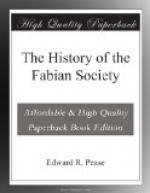In 1907 and 1908 the Society consisted largely of new members; consequently the meetings were crowded and we were driven out from one hall after another. Moreover the propagandist enthusiasm of Mr. Wells and the glamour of his name helped to attract a large number of distinguished persons into our ranks. Mr. Granville Barker was one of the most active of these. He served on the Executive from 1907 to 1912 and took a large share in the detailed work of the Committees, besides giving many lectures and assisting in social functions. The Rev. R.J. Campbell, who addressed large meetings on several occasions, as also elected to the Executive for the year 1908-9, but did not attend a single meeting. Mr. Aylmer Maude joined the Executive in 1907, held office to 1912, and is still a working member of the Society. Arnold Bennett, Laurence Irving, Edgar Jepson, Reginald Bray, L.C.C. (member of the Executive 1911-12), Sir Leo (then Mr.) Chiozza Money, M.P. (who sat on the Executive from 1908 to 1911), Dr. Stanton Coit, H. Hamilton Fyfe, A.R. Orage, G.M. Trevelyan, Edward Garnett, Dr. G.B. Clark (for many years M.P.), Miss Constance Smedley, Philip Snowden, M.P., Mrs. Snowden (Executive 1908-9), George Lansbury, Herbert Trench, Jerome K. Jerome, Edwin Pugh, Spencer Pryse, and A. Clutton Brock are amongst the people known in politics, literature, or the arts who joined the Society about this period.
Some of these took little or no part in our proceedings, beyond paying the necessary subscription, but others lectured or wrote for the Society or participated in discussions and social meetings. These were at this time immensely successful. In the autumn of 1907, for example, Mrs. Bernard Shaw arranged for the Society a series of crowded meetings of members and subscribers at Essex Hall on “The Faith I Hold.” Mrs. Sidney Webb led off and was followed by the Rev. R.J. Campbell, S.G. Hobson, Dr. Stanton Coit, H.G. Wells, and Hubert Bland: with an additional discourse later in the spring by Sir Sydney Olivier. Mr. Wells’ paper, which proved to be far too long for a lecture, was the first draft of his book “First and Last Things”; but he had tired of the Society when it was published, and the preface conceals its origin in something of a mystery. Sir John Gorst, Mrs. Annie Besant, Dr. Suedekum (German M.P.), Sir John Cockburn, K.C.M.G., the Hon. W.P. Reeves, Raymond Unwin, and Sir Leo Chiozza Money were amongst the other lecturers of that year.
* * * * *
In 1906 and succeeding years a new form of organisation was established. Members spontaneously associated themselves into groups, “The Nursery” for the young, the Women’s Group, the Arts Group, and Groups for Education, Biology, and Local Government. The careers of these bodies were various. The Arts Group included philosophy, and, to tell the truth, almost excluded Socialism. But all of us in our youth are anxiously concerned about philosophy and




